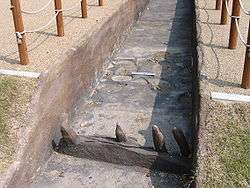Takamatsu Castle (Bitchū)
| Takamatsu Castle | |
|---|---|
| 高松城 | |
| Okayama, Okayama Prefecture, Japan | |
|
An excavated portion of the dike and embankment base constructed by Toyotomi Hideyoshi in his 1582 siege of the castle. | |
| Type | Azuchi-Momoyama castle |
| Site information | |
| Controlled by | Ishikawa clan (until 1575), Mōri clan (1575–1582), Toyotomi Hideyoshi (1582–1598), Hanabusa clan (c. 1598 – mid-17th century) |
| Condition | Archaeological site and designated national historical site; signs of Hideyoshi's siege equipment and dikes remain, but remnants of the castle do not. |
| Site history | |
| Built | late 16th century |
| Built by | Mimura clan |
| In use | late 16th to mid-17th centuries |
| Materials | Wood, stone, plaster |
| Battles/wars | Siege of Takamatsu (1582) |
| Garrison information | |
| Past commanders | Shimizu Muneharu (c. 1575–1582) |
Takamatsu Castle (高松城 Takamatsu-jō) of Bitchū Province was a Japanese castle located in what is today the city of Okayama in Okayama Prefecture. Like most Japanese castles, it was built in the late 16th century, during the Azuchi–Momoyama period of Japanese history.
The castle, of the hirajō (plains castle) type, was built very close to sea level, on somewhat marshy ground, which formed something of a natural moat; this distinguishes it from the more stereotypical image of a yamashiro (mountain castle), built atop a hill. It was originally built by the Mimura family, and controlled by their vassals, the Ishikawa family. Both families were eliminated as significant powers by the Mōri clan, who seized Takamatsu, and all of Bitchu province, in 1575. The Mōri entrusted the castle to their vassal Shimizu Muneharu. Shimizu was closely related to the Ishikawa family, and it's possible that he was already lord of Takamatsu shortly before the Mōri attacked, turning to their side upon the defeat of the Ishikawa, in order to maintain his own prestige and power, along with the castle.
In 1582, the castle was besieged by Toyotomi Hideyoshi. After a month or two of siege, Hideyoshi built dikes to divert a nearby river, at the suggestion of his strategist Kuroda Kanbei, and flooded the castle, leading to a quick surrender on the part of Shimizu. The ease with which this was accomplished was brought about in great part due to the marshy condition of the area, and the timing of the siege: the rainy season (tsuyu) exacerbated the flooding to such an extent that it is easy to imagine the fortress truly being literally flooded, and surrender becoming quite inevitable.
Following this siege, and the rise and fall of Toyotomi Hideyoshi, the castle came to be controlled by the Hanabusa family, karō of the Ukita family. Following the battle of Sekigahara in 1600, in which the Hanabusa fought alongside the army of Tokugawa Ieyasu, they were awarded hatamoto status; ranked higher than most daimyo (feudal lords), the hatamoto were among the shogun's most trusted retainers. Some years later, however, the daimyo residence was moved from Takamatsu to Abe, in what is today Sōja city.
Today, though some remnants of Hideyoshi's dikes and siege towers remain, signs of the castle itself do not. A stone monument marks the spot where Shimizu Muneharu committed seppuku, and the whole surrounding area has been made a park, Takamatsu Castle Water-Siege Historic Park (高松城水攻め史跡公園, Takamatsu-jō mizuzeme shiseki kōen). Archaeological markers, such as wooden posts, mark the area where the castle, dikes, and siege equipment were located.
Takamatsu Castle in Popular Culture
Takamatsu Castle was featured in Namco's Soulcalibur as Mitsurugi's stage. There are two versions of the stage, one during the siege, and the other takes place in the winter when the fighting has stopped.
References
| Wikimedia Commons has media related to Takamatsu Castle (Bitchu). |
- Much of the content here is derived from that on the corresponding article on the Japanese Wikipedia.
- Sansom, George (1961). A History of Japan: 1334–1615. Stanford, California: Stanford University Press
- Turnbull, Stephen (1998). The Samurai Sourcebook. London: Cassell & Co.
Coordinates: 34°41′34.8″N 133°49′19.36″E / 34.693000°N 133.8220444°E
